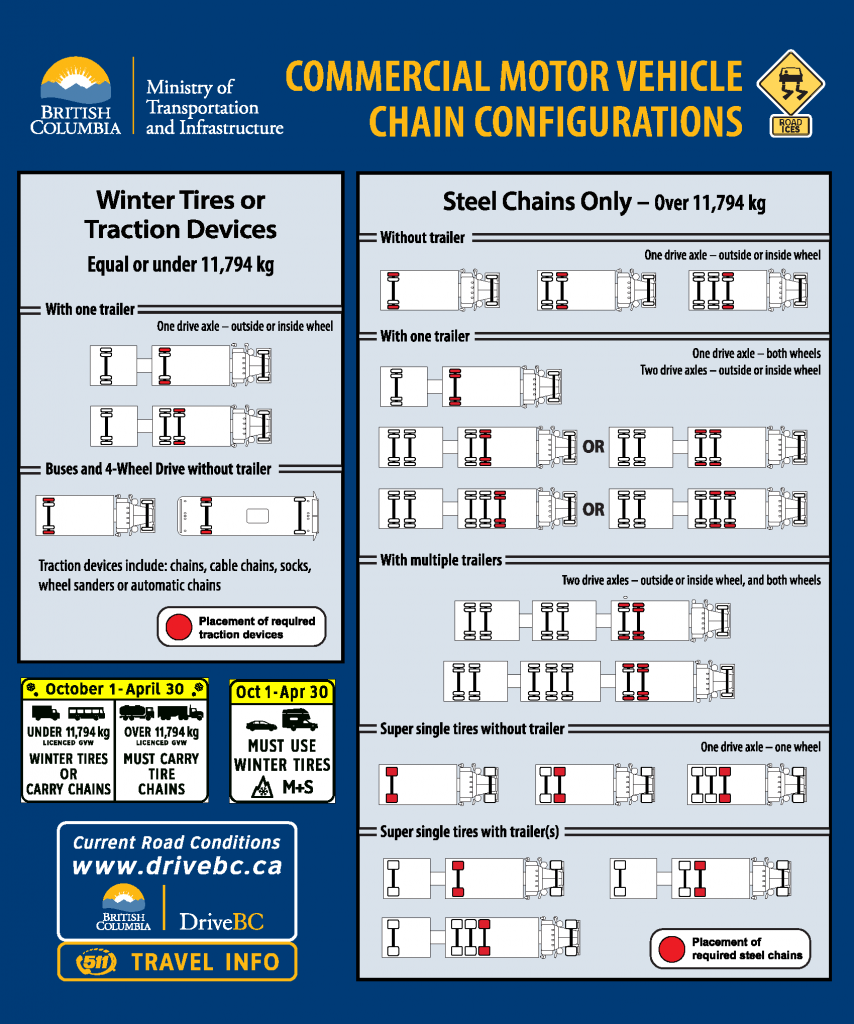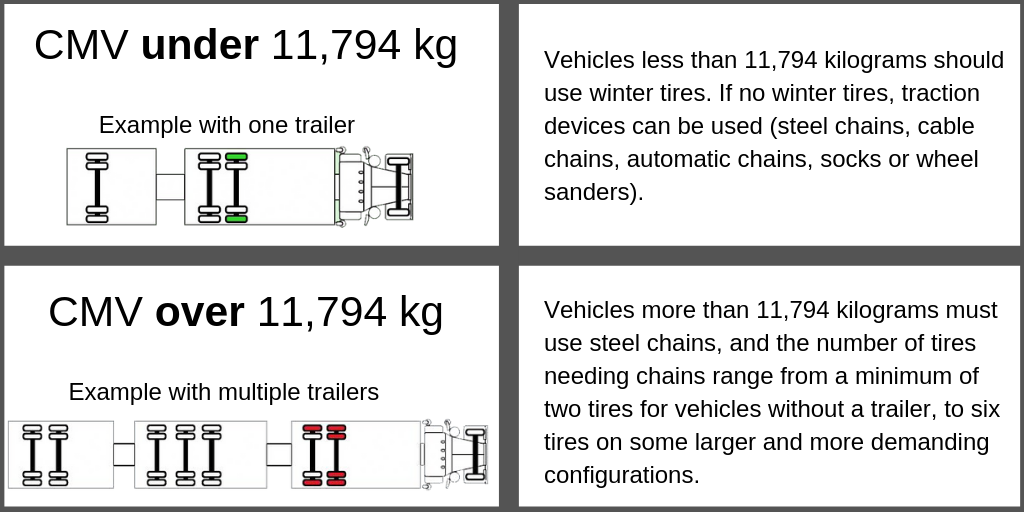
We introduced better chain-up regulations for commercial vehicles, which provide more clarity for professional drivers, in 2018. This means safer roads.
The changes came in the wake of one of our worst winters for highway closures. Unprepared commercial trucks caused 41 highway closures because they were either poorly equipped or totally unequipped with chains. In some cases, this was due to the driver’s inability to install the chains properly. Loss of traction in winter conditions leads to collisions and commercial vehicles simply spinning out on hills and blocking all lanes until they can be towed.
The old regulations were not as thorough, requiring vehicles over 27,000 kilograms to carry and use chains or other traction devices, with only one wheel needing a traction device during winter conditions and mandatory chain-ups.
Professional drivers who were properly equipped were often delayed due to these closures.
We’re doing better than that now…

What’s Different?
The rules clearly spell out safe chain-up configurations for all commercial vehicles over 5,000 kilograms.
See the top of this blog post for the full visual guide to commercial vehicle chain configurations. But let us also break down the minimum requirements here:
STEEL CHAINS ONLY
CMV over 11,794 kg without trailer
- Two outside drive tires must be chained for trucks with one, two, or three rear axles. If the truck has more than one rear drive axle, we recommend the chains be installed on the rear drive axle closest to the front (as shown in graphics) because the front will chew up the compact and create a rough surface for the subsequent tires. Depending on weight distribution, some drivers may prefer to put them on the drive axle(s) closest to the rear.
CMV over 11,794 kg with one trailer
- Four drive tires must be chained for trucks with one, two, or three rear axles. All four chains can go on one drive axle, or distributed to the outside tires of two drive axles. If more than one rear drive axle, we recommend chains be installed on the rear axle(s) closest to the front.
CMV over 11,794 kg with multiple trailers
- Six drive tires should be chained: all four tires of the first drive axle, and the two outside tires of the second drive axle.
CMV over 11,794 kg with super single tires without trailers
- Both tires of the first drive axle should be chained.
CMV over 11,794 kg with super single tires with trailer(s)
- Trucks with one drive axle must have both tires chained. Trucks with two or three drive axles must have all four tires on the first and second drive axles chained.
WINTER TIRES or TRACTION DEVICES [Vehicles equal or under 11,794 kg may use winter tires and/or acceptable traction devices (chains, cable chains, socks, wheel sanders or automatic chains)]
CMV equal or under 11,794 kg with one trailer
- Two outside drive tires must have traction devices for trucks with one or two drive axles. If more than one axle, we recommend the drive axle closest to the front be equipped.
Buses, 4-wheel drive and CMV equal or under 11, 794 kg without trailer
- Two outside rear tires must have winter tires or traction devices.
- Motor coach buses travelling across BC’s mountain passes, regardless of LGVW (bigger and smaller than 11,794 kg) need either winter tires, or some sort of traction device such as: steel chains, cables, auto-socks etc.
Thank you to everyone in the commercial trucking industry who took part in the summer 2018 survey about the proposed changes. We gained some valuable insight, including:
- Over 70 per cent of commercial drivers surveyed approved of enhancements to the quality of, and requirements for, traction devices.
- Over 90 per cent said they are already compliant with the regulations.
- Over 80 per cent said they have the tools and training in place to implement the proposed regulations.
Along with the stricter chain-up regulations, commercial vehicles are restricted from using the left lane northbound on the Coquihalla between Box Canyon and Zopkios, as well as Larson Hill and Inks Lake Hill. This is to prevent multiple spin-outs from closing the highway. In the event of a severe weather event, CVSE and traffic control will be directing commercial drivers to chain-up at the newly expanded Box Canyon Chain-up area.
Of course, carrying chains is useless unless you know how to install them. Please make sure you hit the road with the knowledge and ability to follow the new chain-up regulations. Here is a video that guides you through installation from our highway maintenance contractor, Emcon Services:
Join the discussion